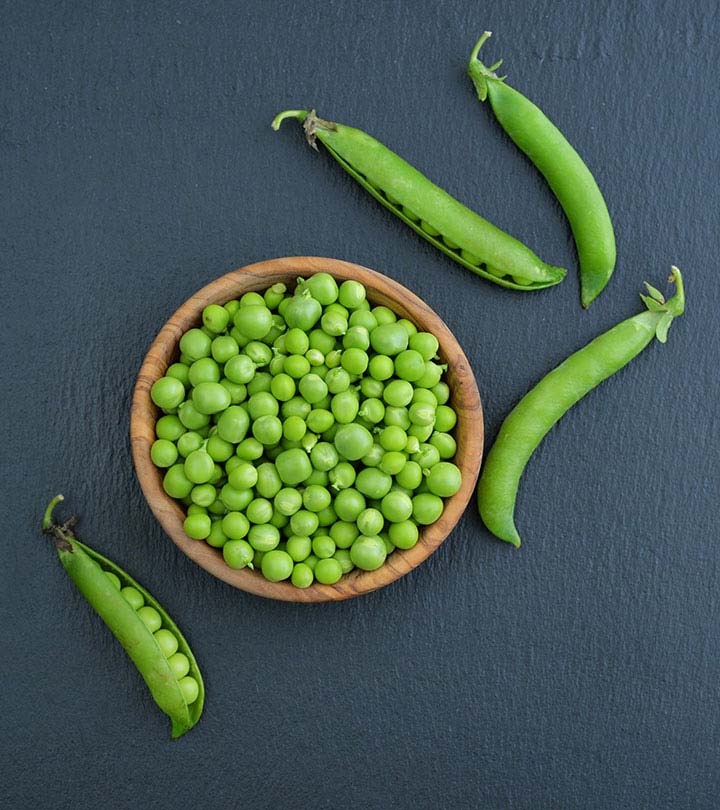The benefits of green peas make them a must-have addition to your diet. They are packed with dietary fiber, starch, protein, vitamins, and beneficial phytochemicals.
“Green peas are an excellent source of protein for vegetarians and vegans, and food manufacturers are now using pea protein in the making of various plant-based products, such as non-dairy beverages, meatless burgers, and pea protein powder,” says Vandana Gujadhur, RD. She adds “Like any other legume, green peas are low in the essential fatty acid methionine. This can be compensated by including a variety of grains in the diet.”
The peas are nutritious and wholesome, as do most legumes. Learn more about green pea’s nutritional value below
This article discusses the benefits of green peas, their nutritional profile, and any potential side effects. Take a look.
In This Article
What Are Green Peas?
The peas are nutritious and wholesome, as do most legumes. Learn more about green pea’s nutritional value below
The green pea or garden pea (Pisum sativum) is the seed of the plant that grows in hard pods. It is a type of legume and a climbing annual plant that originated from Southeast Asia. It is an important food legume, ranking fourth in the world in terms of legume production (1).
Green peas are featured across several cuisines. They are consumed raw, boiled, steamed, or their pods are stir-fried. Their starch content makes these legume seeds mildly sweet.
Fun Fact Since 1984, Janet Harris, from Sussex, holds the world record for eating the most peas. She ate 7175 peas, one at a time, using chopsticks in just under 60 minutes.
The peas are nutritious and wholesome, as do most legumes. Learn more about green pea’s nutritional value below.
Green Peas Nutrition Facts
- A serving of peas (100 g) has 79 calories, 13 g of carbohydrates, of which about 4 grams is dietary fiberand 4.5 grams of protein.
- Peas are an excellent source of vitamin A (765 IU), vitamin C (40 mg), vitamin E (0.13), and vitamin K (24.8 µg) (2).
- They are rich in minerals, like selenium (1.8 µg) and zinc (1.24 mg), and phytonutrients, like ß-carotene (449 µg) and lutein-zeaxanthin (2477 µg) (2).
- Flavanols, such as catechin and epicatechin, phenolic acids (caffeic and ferulic acid), and saponins are a few of the phytonutrients present in peas (2).
In the following section, we will explore the major health benefits of green peas.
Health Benefits Of Green Peas
Shutterstock
1. May Help Manage Blood Sugar And Diabetes
“Green peas rate low on the Glycemic Index scale as they are high in dietary fiber, which slows down the breakdown of carbohydrates in the blood.Hence, you will not experience a sugar spike,” says Vandana Gujadhur, RD.
Low GI foods are beneficial in the prevention and management of type 2 diabetes (3).
In mice studies, raw pea extracts could inhibit the activity of a particular enzyme (pancreatic amylase) involved in carbohydrate metabolism. This could explain the hypoglycemic effect of pea extracts in mice (4). More studies are needed to understand the anti-diabetic effects of green peas.
Related: Easy Ways To Lower Blood Sugar Naturally And Safely
2. May Improve Digestion
Shutterstock
Peas contain prebiotic sugars and fiber that may be beneficial in the digestive process. The galactose oligosaccharides in peas were found to help with the digestion in the large intestine (5).
Prebiotic sugars become fodder for the probiotic bacteria during digestion. This helps the good bacteria to use these sugars and convert them to products that are beneficial to our body.
Fiber helps in the movement of food through the digestive tract. This is essential for proper digestion and elimination of toxic substances.
Pea sprouts also have antimicrobial effects. The phenolic extracts of sprouted peas inhibited the growth of Helicobacter pylori, the ulcer-causing bacteria (6). Including green peas in the diet can improve the overall gastrointestinal function.
3. May Help Lower Blood Cholesterol Levels
Shutterstock
Managing cholesterol levels can help prevent cardiovascular diseases. An excess of low-density lipoprotein, or LDL, is harmful to the body. It clogs the arteries and may lead to heart disease. In studies on pigs on a high cholesterol diet, peas reduced their plasma levels of total and LDL cholesterol (7). The soluble fiber in green peas may also lower the risk of cardiac disease.
4. May Help Reduce Inflammation
Chronic inflammation and oxidative stress can lead to cardiovascular disorders, neurological disorders, and cancer. Hence, it becomes increasingly important to include anti-inflammatory foods in our diets as we age in order to manage inflammation (8). The powerful antioxidant and anti-inflammatory properties of green peas can fight oxidative damage and may help reduce cancer risk (9). These antioxidants bind to free radicals and reduce their ill effects on the body.
Extracts of peas exhibited anti-inflammatory activity in animal studies (10).
Related: Skin Inflammation: Causes, Symptoms, Diagnosis, And Treatment
5. May Help Reduce The Risk Of Cancer
The legume family is known for being rich in anti-cancer compounds. Green peas contain certain inhibitors that have shown to reduce the risk of colon cancer (11).
Several other compounds in green peas, such as lectins and saponins, have also exhibited anticancer activity (12). Studies have shown that isoflavones and phenolic compounds present in green peas have anticancer effects on liver, colon, lung, and breast cancer cells (1).
6. Good Source Of Antioxidants
Green peas are packed with potent antioxidants such as phenolic compounds. They contain tannins that have shown to have a high antioxidant activity (5). These beneficial compounds protect our cells from damage and early cell death. Antioxidants help scavenge free radicals and reduce the risk of chronic health complications (13).
Given the health benefits of green peas, it is wise to include them in the diet. They are easy to add into meals and are readily available to purchase or you can grow your own. However, peas may not suit everyone, and it is possible that they may cause certain side effects in some people.
Related: 15 Benefits Of Antioxidants And Their Best Sources
Side Effects Of Green Peas
Shutterstock
Green peas may lead to side effects in certain individuals. Always consult a registered dietitianbefore making any changes to your diet.
Green peas contain anti-nutrients like phytic acid and lectins that may interfere with nutrient absorption. These anti-nutrients may also cause digestive problems (14), (15).
The phytic acid in peas may hamper the absorption of minerals like iron and zinc (16). This can eventually lead to nutritional deficiencies.
Lectins present in fresh peas can disturb the delicate balance of the immune system and bacterial population in the gut (15).
However, soaking, fermenting or cooking peas can potentially reduce these antinutrients (17). Also, reducing the portion size of peas can help decrease the risk of side effects.
In order to avoid further health complications, it is important to store and select green peas properly. Good produce will help you get the nutrients you need, and good storage will extend its shelf life. Here’s how to pick and store green peas effectively so they last as long as possible.
How To Select And Store
Shutterstock
Throughout the year, you can find green peas in canned or frozen forms. Fresh peas are available in particular seasons, mainly in April.
Here’s what to look for when picking and storing fresh peas:
- Choose firm, medium-sized bulging pods without any cracks or limps.
- A good pea pod produces a sharp snap when broken into two and has round green, smooth, and slightly sweet peas.
- It is best to store them in a ziplock bag or an airtight container in the fridge for a few days or to blanch and freeze them for six months.
If you choose canned or frozen peas:
- Select canned peas with low sodium content or thoroughly wash the peas before cooking (if you want to avoid excess sodium).
- Check the expiration date and storage conditions mentioned on the label. It is recommended to consume them within 12 months from the packaging date.
Did You Know? Clarence Birdseye, the inventor of the ‘plate froster’ that is used to preserve foods, was the first individual to make frozen peas.
Infographic: Benefits Of Green Peas
Green peas are known for their unique taste and are widely used in many cuisines worldwide. They are loaded with many beneficial nutrients that can be attributed to the array of health benefits they offer.
The following infographic provides information on the various health benefits of green peas. Check it out!
The health benefits of green peas can be attributed to their rich nutrients, fiber, and protein. They are replete with phytonutrients and essential amino acids too. They can be added to your favorite salads, soups, or dishes. Intake of green peas mayimprove digestion and protect against chronic diseases. However, excess intake of green peas may cause digestive issues as they contain anti-nutrients. These can be reduced by soaking, fermenting, or cooking them. Prepare them properly and you will be able to enjoy the benefits of the peas to the maximum.




